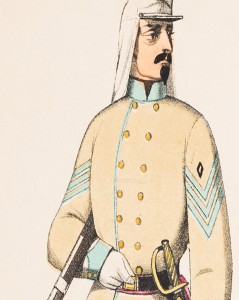By: Lindsay Smith, Melissa Young, and Rachel K. Deale, History PhD students, and Amy Chen, CLIR Postdoctoral Fellow
This post is the third in a five-part series titled “Curating the Confederacy: An Interview with the curators of Making Confederates and When this Cruel War is Over.” If you haven’t yet, please read the first and second installments of this series.
What was your favorite discovery while conducting research for these shows? “Discovery” can be a favorite item, a new piece of information, or even an insight into the era you represented in your exhibition.
Rachel: I really enjoyed learning about the Confederate publishers. Before I began working on my exhibit I knew where most of the major Confederate publishers were located, but I did not know a lot about the individual publishing houses such as George Dunn & Company, Blackmar and Company, and John C. Schreiner & Son. I was also fascinated in learning more about how songwriter Charles Carroll Sawyer became popular in both the North and South throughout the war.
Lindsay: Melissa and I found a letter written penciled onto the last page of a sermon. It was from a soldier to his mother, telling her that he’d heard the sermon given a few weeks prior and that he was now sending it home to her. He made sure to tell her that all was well and that he still had his health. There are things like that all over this material if you sit and look at it: an underlined verse the Bible, someone’s name scrawled onto the cover page of a favorite book, or pages that are folded down to a specific spot. Every time I came across something like that I was reminded that all these items belonged to someone, and even though I don’t know the individual owners or their story, these materials link us to them and their experiences in some way.
Melissa: We came across so many fabulous things, it is really difficult to chose just one! I really enjoyed looking at passages in the textbooks and the novels, which often drip so heavily with Confederate nationalism that the words are almost shocking. I also loved the colored plates in the Uniform and Dress of the Army of the Confederate States that librarian Jennifer Cabanero drew to our attention. Perhaps my favorite was the note we discovered in the back of J.J. Renfroe’s published sermon “The Battle is God’s,” which is featured in the “Soldier’s Life” case at the front of the show. The Confederate soldier appeared to have scratched a few quick lines to his mother in pencil, obviously desiring her to read a sermon he had heard and liked. It made the war and everything we were looking at eerily personal. Since it was one of the first things we came across that really made an impact, it set the tone for many of our other discoveries.
What was the most difficult part of the process of creating your exhibition?
Rachel: The most difficult part of the process is choosing what to display in the exhibit. There were many pieces of sheet music that I could have displayed but did not have the space to do so.
Lindsay: I think it would definitely be picking what made it into the exhibition and what was left out. There is just so much amazing stuff!
Melissa: For me, the most difficult part was meeting deadlines that coincided with much of the work I was doing on other papers and projects. It was definitely challenging to balance everything, but Lindsay was a great partner. We communicated well and were assisted and supported by the fabulous librarians at UA, including Jennifer Cabanero and Nancy DuPree.


